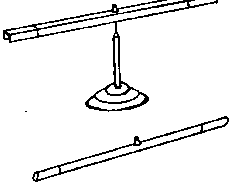E.1(1) – Pith Balls
A tall stand holds two strings with a pith ball at each end. It makes use of the lightness of pith, a plant matter, to indicate electrical charges. The pith balls can be coated with a metallic paint or with an insulating paint. They react immediately to static charges: when one brings a charged friction rod close to the pith balls, they are attracted to the charged rod. After touching it, they repel the rod and each other if they are conductors or they cling to the rod if they are insulators. A single hanging pith ball works as an electroscope.
A friction rod held in the horizontal plane, so that it can turn freely, is also a good demonstration of the attractive and repulsive electrostatic forces.

E.1(2) – Braun Electroscope
These electroscopes provide good visibility and sensitivity for basic static electricity demonstrations. One of them has a cylindrical metal case with a metal holder projecting down into the case: a light soda straw covered with a metal paint is balanced on this holder with a pin through its midpoint so it can swing freely. When a charged friction rod is brought close to the electroscope, electrostatic repulsion will deflect the straw from its normal vertical position. The metal holder and the metallic straw (or a metallic needle) have identical excessive charge.
These are many different types available.

E.1(3) – Leaf Electroscope
A cylindrical metal case has two plane parallel glass windows and is mounted on a metal base. A metal holder projects down into the case holding a metal leaf on the top. It is about 20 cm high, and the metal case is about 10 cm in diameter. It can be projected for better visibility.

E.1(4) – Demonstration Electroscope
It consists of an insulated support with a needle point and two interchangeable sticks: a conductor and a non conductor, but looking identical. This apparatus can effectively demonstrate induction, attraction and repulsion and the different behavior of conductors and nonconductors.

E.1(5) – Stream of Water
A charged rod will attract a thin stream of water. Although clearly seen at close range, for a large class it is not very good.
Click here to see a video of this demo.

E.1(6) – Electrophorus
It is used to produce a large static electric charge by induction. Rub the plexiglas’s plate with a silk or wool cloth, and under favorable conditions, it will produce a spark almost .5 cm in length. The base is a plexiglas’s plate about 30 cm x 30 cm. An aluminum plate, about 25 cm x 25 cm, is used to collect charge. The aluminum plate has a 15 cm Lucite handle.
Rub the base with a piece of silk. Rest the aluminum plate over it. Touch the aluminum plate and lift it by its handle. One can feel the spark by touching the aluminum plate but a better demonstration is to bring it close to a neon bulb socket: it will light it up for a second. Dim the lights for a more impressive effect.

E.1(7) – Induction Spheres
With the help of an electroscope the Induction Spheres can be used to demonstrate the phenomenon of induction. It also shows that induction is really the separation of two kinds of electricity in any body. Each sphere is 10 cm in diameter and they stand about 25 cm tall.
